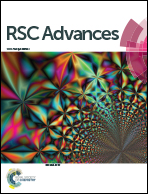Formation and phase transition of hydrogel in a zwitterionic/anionic surfactant system
Abstract
The phase behavior and microstructure in a mixture of the zwitterionic surfactant N-hexadecyl-N,N-dimethyl-3-ammonio-1-propane sulfonate (HDPS) and anionic surfactant sodium dodecylsulfate (SDS) were studied. Analysis of its macroscopic appearance, tube inversion testing and rheological measurements were employed to characterize its phase behavior, and it was found that a hydrogel formed in an appropriate total concentration (CT) and molar percentage of SDS (XSDS) at 25 °C for HDPS/SDS systems. Microstructures in the hydrogel were identified to be long wormlike micelles and small spherical vesicles, using transmission electron microscopy (TEM). The coexistence of wormlike micelles and small vesicles brings an appropriate packing parameter (p), which indicates that the wormlike micelles reached a sufficient length and degree of entanglement to form the three-dimensional elastic hydrogel. The HDPS/SDS hydrogel transforms into a viscoelastic sol upon increasing the temperature, and the determined gel–sol transition temperature (Tg–s) has been determined to be around 30 °C, using optical and rheological methods. Besides, adding salt causes the wormlike micelles to lengthen and the rheological properties of the solution to change, such that it may even induce a sol–gel phase transition in the mixed zwitterionic and anionic surfactant system.


 Please wait while we load your content...
Please wait while we load your content...